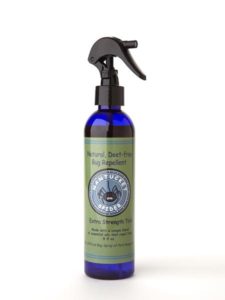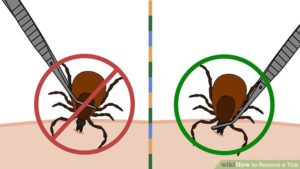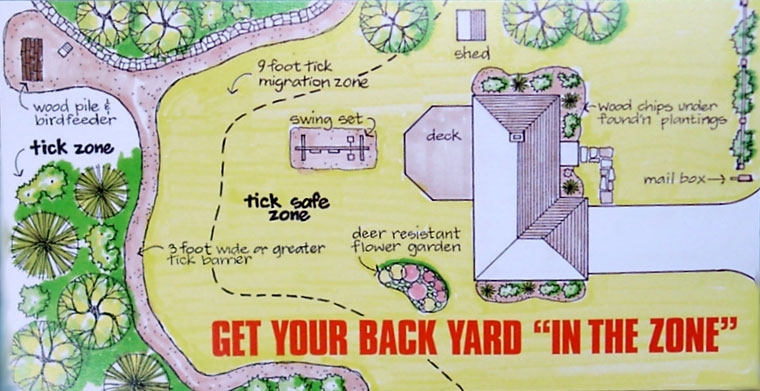How to Prevent Tick Bites and Lyme Disease
Excerpted from Johns Hopkins’ Lyme Disease Research Center
1) Create a tick-free zone around your house
- Keep your lawn well manicured
- Create a tick barrier between your lawn and taller grasses or brush
- Add a deer fence to protect your garden
The first principle in creating a tick-free zone is to have an inner area that is well-manicured. Lawns that are well mown and grass that is well sheared will keep the tick habitat away from your home. We want to separate this tick-free habitat from the woods with a barrier, and often, what is used is called a tick barrier, which is a several-foot-wide strip of wood chips or bark that separates your well-manicured yard and lawn from the brush and taller grasses that may be around the perimeter of your yard. Ticks get Lyme disease from mice, and so we also want to eliminate the mouse habitats around your yard. This would include eliminating wood piles and rock piles where the mice tend to live and breed. Gardeners may also try to keep deer out of their tick-free zone. This can be accomplished with an eight-foot deer fence, and this can be installed by professionals or by yourself.
2) Enjoy the outdoors safely
- Avoid exposure in wooded, overgrown areas
- Stay on marked trails when hiking
- Stay out of tall grass & un-cleared areas of the forest floor
Going for a walk or a hike? Great! Stay in the middle of the paths, away from the high grass and brush that may be on the edges of your hiking trail. Avoid going into the tall grass and brush if you can. Sports and athletic fields with well-groomed grass are safer, just make sure to stay out of the brush and tall grass at the edges of the fields when possible.
3) Protect yourself, your children and your pets by wearing protective clothing treated with tick pesticides and treating your skin with insect repellent
- Wear protective clothing.
- Long sleeves, long pants tucked into socks and shoes
- Avoid going barefoot or wearing open-toe sandals/shoes
- Use insect repellent on the body or Permethrin on clothes.
- Review safety information; assess the risks/benefits of these products. Harvest Market carries a variety of insect repellents and essential oils that are useful for preventing tick bites. We recommend Nantucket Spider’s Extra Strength Tick Repellent, which contains a carefully selected blend of essential oils known to deter ticks plus natural vanillin to extend the product’s effectiveness.
- Make your own natural tick repellent, like this one from Mommypotamus. Essential oils that are effective tick repellents include: geranium, citronella, lemon eucalyptus and catnip.
Lightweight long pants and long shirts are great for hiking as they prevent ticks from getting on your skin. Permethrin is a commonly-used tick pesticide that’s applied to clothing, not to your skin. Permethrin is a unique chemical because it does not need to be reapplied frequently, it stays bound to the material of your clothing and needs only to be reapplied every several months. In addition to treating your clothing with permethrin, you can also use an insect repellent on your skin to repel ticks. It must be applied every two to three hours in warm weather. Apply by spraying on to the exposed surface of the skin and allowing it to dry in place.
When you’re done enjoying the out of doors, it’s a good protective habit to shower immediately, this may wash off ticks that have gotten on to you, and to wash and dry your clothes immediately.
Protecting Your Children
It’s very important to use protective measures for your children as well. Any kind of pesticides or repellents should be used with caution, and it’s important to discuss the use of these with your pediatrician before using them.
Protecting Your Pets
It’s also important to protect your pets from Lyme disease. We recommend Nantucket Spider’s Repellent for Dogs.
4) Perform tick checks after coming in from the out of doors and showering
- The risk of getting Lyme disease is greater the longer a tick is attached. Therefore, doing tick checks is important so they can be removed before they transmit Lyme disease.
- Shower daily.
- Common sites of attachment: underarm, navel, groin, buttocks.

The most important thing is to get ticks off of you before they attach and have the chance to transmit Lyme disease. Tick checks are performed two ways.
- Physical inspections or feeling for ticks, because ticks are very small, and sometimes aren’t seen. By feeling for ticks, you may discover ticks that are in hidden areas, such as behind your knee or in your armpit, where you wouldn’t be able to easily see them.
- Visual inspections should be done as well, looking for the very small pinpoint-sized dark specks that are the nymph stage ticks present at this time of the year.
Especially important areas to check for chicks include behind the knees, under the armpits, in the scalp, especially in children, where ticks tend to be in the scalp, along the waistline, and in areas of the back, where you may need help from somebody to look on your back for ticks. Parents should inspect their child’s entire body daily for ticks.
5) Remove ticks once found immediately by grasping them with a tweezer and pulling them off of the skin
 The quickest way to remove a tick is with tweezers. Grasp the tick between the head of the tick and the skin and to pull firmly but gently away. Sometimes, this will leave behind small black mouthparts of the tick in the skin. Don’t worry, these small mouthparts do not transmit Lyme disease and should be left alone. Never try to dig out the mouthparts of the tick with any type of needle or blade, just leave them in place and they will work their way out on their own.
The quickest way to remove a tick is with tweezers. Grasp the tick between the head of the tick and the skin and to pull firmly but gently away. Sometimes, this will leave behind small black mouthparts of the tick in the skin. Don’t worry, these small mouthparts do not transmit Lyme disease and should be left alone. Never try to dig out the mouthparts of the tick with any type of needle or blade, just leave them in place and they will work their way out on their own.
The most important point is to remove the tick quickly. Removing a tick in the first 24 hours dramatically reduces the risk of Lyme disease, and is your best protection in preventing yourself from getting Lyme disease.
Using these five tips to prevent Lyme disease can help you enjoy the out of doors safely, help you to avoid tick bites, and help you to avoid getting Lyme disease.
Further Reading and Additional Resources:
- Centers for Disease Control
- Tick Dangers and Precautions
- LymeDisease.org
- Lyme Disease Support Group
- Pennsylvania Lyme Resource Network
- Tick Encounter Resource Center
- Lyme Disease Challenge
- International Lyme and Associated Disease Society
- Lyme Disease Association
- National Alliance of Safe Pest Control


